Ultraviolet Laser Damage Dependence on Contamination Concentration in Fused Silica Optics during Reactive Ion Etching Process
Abstract
:1. Introduction
2. Theoretical Details
3. Investigation Experiment of Contamination
4. Optimization Experiment of Contamination
4.1. Optimization Details
4.2. Results and Discussions
5. Conclusions
Acknowledgments
Author Contributions
Conflicts of Interest
References
- Suratwala, T.; Wong, L.; Miller, P.; Feit, M.; Menapace, J.; Steele, R.; Davis, P.; Walmer, D. Sub-surface mechanical damage distributions during grinding of fused silica. J. Non-Cryst. Solids 2006, 352, 5601–5617. [Google Scholar] [CrossRef]
- Neauport, J.; Cormont, P.; Legros, P.; Ambard, C.; Destribats, J. Imaging subsurface damage of grinded fused silica optics by confocal fluorescence microscopy. Opt. Express 2009, 17, 2543–2554. [Google Scholar] [CrossRef]
- Bude, J.; Miller, P.; Baxamusa, S.; Shen, N.; Laurence, T.; Steele, W.; Suratwala, T.; Wong, L.; Carr, W.; Cross, D. High fluence laser damage precursors and their mitigation in fused silica. Opt. Express 2014, 22, 5839–5851. [Google Scholar] [CrossRef] [PubMed]
- Bude, J.; Miller, P.E.; Shen, N.; Suratwala, T.; Laurence, T.; Steele, W.; Baxamusa, S.; Wong, L.; Carr, W.; Cross, D.; et al. Silica laser damage mechanisms, precursors and their mitigation. Proc. SPIE 2014, 9237, 92370S. [Google Scholar]
- Baxamusa, S.H.; Miller, P.E.; Wong, L.L.; Steele, R.; Shen, N.; Bude, J.D. Mitigation of organic laser damage precursors from chemical processing of fused silica. Opt. Express 2014, 22, 29568–29577. [Google Scholar] [CrossRef] [PubMed]
- Liao, W.; Dai, Y.; Liu, Z.; Xie, X.; Nie, X.; Xu, M. Detailed subsurface damage measurement and efficient damage-free fabrication of fused silica optics assisted by ion beam sputtering. Opt. Express 2016, 24, 4247–4257. [Google Scholar] [CrossRef] [PubMed]
- Frost, F.; Fechner, R.; Flamm, D.; Ziberi, B.; Frank, W.; Schindler, A. Ion beam assisted smoothing of optical surfaces. Appl. Phys. A 2004, 78, 651–654. [Google Scholar]
- Shi, F.; Zhong, Y.; Dai, Y.; Peng, X.; Xu, M.; Sui, T. Investigation of surface damage precursor evolutions and laser-induced damage threshold improvement mechanism during Ion beam etching of fused silica. Opt. Express 2016, 24, 20842–20854. [Google Scholar] [CrossRef] [PubMed]
- Shi, F.; Tian, Y.; Peng, X.; Dai, Y. Combined technique of elastic magnetorheological finishing and HF etching for high-efficiency improving of the laser-induced damage threshold of fused silica optics. Appl. Opt. 2014, 53, 598–604. [Google Scholar] [CrossRef] [PubMed]
- Sun, L.; Liu, H.; Huang, J.; Ye, X.; Xia, H.; Li, Q.; Jiang, X.; Wu, W.; Yang, L.; Zheng, W. Reactive ion etching process for improving laser damage resistance of fused silica optical surface. Opt. Express 2016, 24, 199–211. [Google Scholar] [CrossRef] [PubMed]
- Jiang, X.; Liu, Y.; Liu, Z.; Qiu, K.; Xu, X.; Hong, Y.; Fu, S. Optimum inductively coupled plasma etching of fused silica to remove subsurface damage layer. Appl. Surf. Sci. 2015, 355, 1180–1185. [Google Scholar] [CrossRef]
- Sun, L.; Jin, H.; Ye, X.; Liu, H.; Wang, F.; Jiang, X.; Wu, W.; Zheng, W. Surface modification and etch process optimization of fused silica during reaction CHF3–Ar plasma etching. Optik 2016, 127, 206–211. [Google Scholar] [CrossRef]
- Yan, Z.; Liao, W.; Zhang, Y.; Xiang, X.; Yuan, X.; Wang, Y.; Ji, F.; Zheng, W.; Li, L.; Zu, X. Optical characterization and laser damage of fused silica optics after ion beam sputtering. Optik 2014, 125, 756–760. [Google Scholar] [CrossRef]
- Catrin, R.; Neauport, J.; Taroux, D.; Maunier, C.; Lambert, S.; Rondeau, O. Contamination of fused silica optics surface after magnetorheological polishing. In Proceedings of the Optical Fabrication and Testing (Optical Society of America), Kohala Coast, HI, USA, 22–26 June 2014. [Google Scholar]
- Paul, A.; Dimri, A.; Bajpai, R. Plasma etching processes for the realization of micromechanical structures for MEMS. (MoO3) x thin films. J. Indian Inst. Sci. 2013, 81, 669–674. [Google Scholar]
- Oehrlein, G.S. Dry etching damage of silicon: A review. Mater. Sci. Eng. B 1989, 4, 441–450. [Google Scholar] [CrossRef]
- Bell, F.H.; Joubert, O.; Oehrlein, G.S.; Zhang, Y.; Vender, O. Investigation of selective SiO2-to-Si etching in an inductively coupled high-density plasma using fluorocarbon gases. J. Vac. Sci. Technol. A 1994, 12, 3095–3101. [Google Scholar] [CrossRef]
- Paul, A.K.; Dimri, A.K.; Mohan, S. Fabrication of micromechanical structures in silicon using SF6/O2 gas mixtures. Proc. SPIE 1999, 3903, 2–8. [Google Scholar]
- Juškevičius, K.; Buzelis, R.; Samuilovas, R.; Abbas, S.; Abromavičius, G.; Puzas, A.; Drazdys, R. Plasma etching of fused silica substrates for manufacturing high laser damage resistance optical interference coatings. In Proceedings of the Optical Interference Coatings, Tucson, AZ, USA, 19–24 June 2016; p. WD.9. [Google Scholar]
- Hrubesh, L.W.; Norton, M.A.; Molander, W.A. Methods for mitigating surface damage growth on NIF final optics. Proc. SPIE 2002, 4679, 23–33. [Google Scholar]
- Choi, D.Y.; Lee, J.H.; Kim, D.S.; Jung, S.T. Formation of plasma induced surface damage in silica glass etching for optical waveguides. J. Appl. Phys. 2004, 95, 8400–8407. [Google Scholar] [CrossRef]
- Shen, X.A.; Jones, S.C.; Braunlich, P. Laser heating of free electrons in wide-gap optical materials at 1064 nm. Phys. Rev. Lett. 1989, 62, 2711–2713. [Google Scholar] [CrossRef] [PubMed]
- Rubenchik, A.M. Implications of Nanoabsorber Initiators for Damage Probability Curves, Pulselength Scaling and Laser Conditioning. Proc. SPIE 2004, 5273, 74–82. [Google Scholar]
- Gao, X.; Feng, G.; Han, J.; Zhai, L. Investigation of laser-induced damage by various initiators on the subsurface of fused silica. Opt. Express 2012, 20, 22095–22101. [Google Scholar] [CrossRef] [PubMed]
- Carr, C.W.; Bude, J.D.; DeMange, P. Laser-supported solid-state absorption fronts in silica. Phys. Rev. B 2010, 82, 184304. [Google Scholar] [CrossRef]
- Bude, J.; Guss, G.; Matthews, M.; Spaeth, M.L. The effect of lattice temperature on surface damage in fused silica optics. Proc. SPIE 2007, 6720, 672009. [Google Scholar]
- Raman, R.; Demos, S.G.; Shen, N.; Feigenbaum, E.; Negres, R.A.; Elhadj, S.; Rubenchik, A.M.; Matthews, M.J. Damage on fused silica optics caused by laser ablation of surface-bound microparticles. Opt. Express 2016, 24, 2634–2647. [Google Scholar] [CrossRef] [PubMed]
- Génin, F.Y.; Kozlowski, M.R.; Feit, M.D. Contamination Effects on Optical Damage; Office of Scientific & Technical Information Technical Reports; Lawrence Livermore National Lab: Livermore, CA, USA, 2 March 1998. [Google Scholar]
- Liu, H.; Huang, J.; Wang, F.; Zhou, X.; Ye, X.; Zhou, X.; Sun, L.; Jiang, X.; Sui, Z.; Zheng, W. Subsurface defects of fused silica optics and laser induced damage at 351 nm. Opt. Express 2013, 21, 12204–12217. [Google Scholar]
- Agraharam, S.; Hess, D.W.; Kohl, P.A.; Allen, S.A.B. Plasma chemistry in fluorocarbon film deposition from pentafluoroethane/argon mixtures. J. Vac. Sci. Technol. A 1999, 17, 3265–3271. [Google Scholar] [CrossRef]
- Rueger, N.R.; Beulens, J.J.; Schaepkens, M.; Doemling, M.F.; Mirza, J.M.; Standaert, T.E.F.M.; Oehrlein, G.S. Role of steady state fluorocarbon films in the etching of silicon dioxide using CHF3 in an inductively coupled plasma reactor. J. Vac. Sci. Technol. A 1997, 15, 1881–1889. [Google Scholar] [CrossRef]
- Xin, Y. Optical emission study of CH4 + CHF3 ECR plasma and properties of a-fluorocarbon: H films. Surf. Coat. Technol. 2003, 173, 172–177. [Google Scholar] [CrossRef]
- Ye, X.; Huang, J.; Liu, H.; Geng, F.; Sun, L.; Jiang, X.; Wu, W.; Qiao, L.; Zu, X.; Zheng, W. Advanced Mitigation Process (AMP) for Improving Laser Damage Threshold of Fused Silica Optics. Sci. Rep. 2016, 6, 31111. [Google Scholar] [CrossRef] [PubMed]
- Chung, C.; Chang, H. Heating-mode transition in the capacitive mode of inductively coupled plasmas. Appl. Phys. Lett. 2002, 80, 1725–1727. [Google Scholar] [CrossRef]
- Miyoshi, Y.; Petrovic, Z.L.; Makabe, T. Transition between capacitive and inductive mode in inductively coupled plasma observed by emission computerized tomography. IEEE Trans. Plasma Sci. 2002, 30, 130–131. [Google Scholar] [CrossRef]
- Barz, J.P.; Oehr, C.; Lunk, A. Analysis and modeling of gas-Phase processes in a CHF3/Ar discharge. Plasma Process. Polym. 2011, 8, 409–423. [Google Scholar] [CrossRef]
- Bose, D.; Rao, M.; Govindan, T.; Meyyappan, M. Uncertainty and sensitivity analysis of gas-phase chemistry in a CHF3 plasma. Plasma Sources Sci. Technol. 2003, 12, 225. [Google Scholar] [CrossRef]

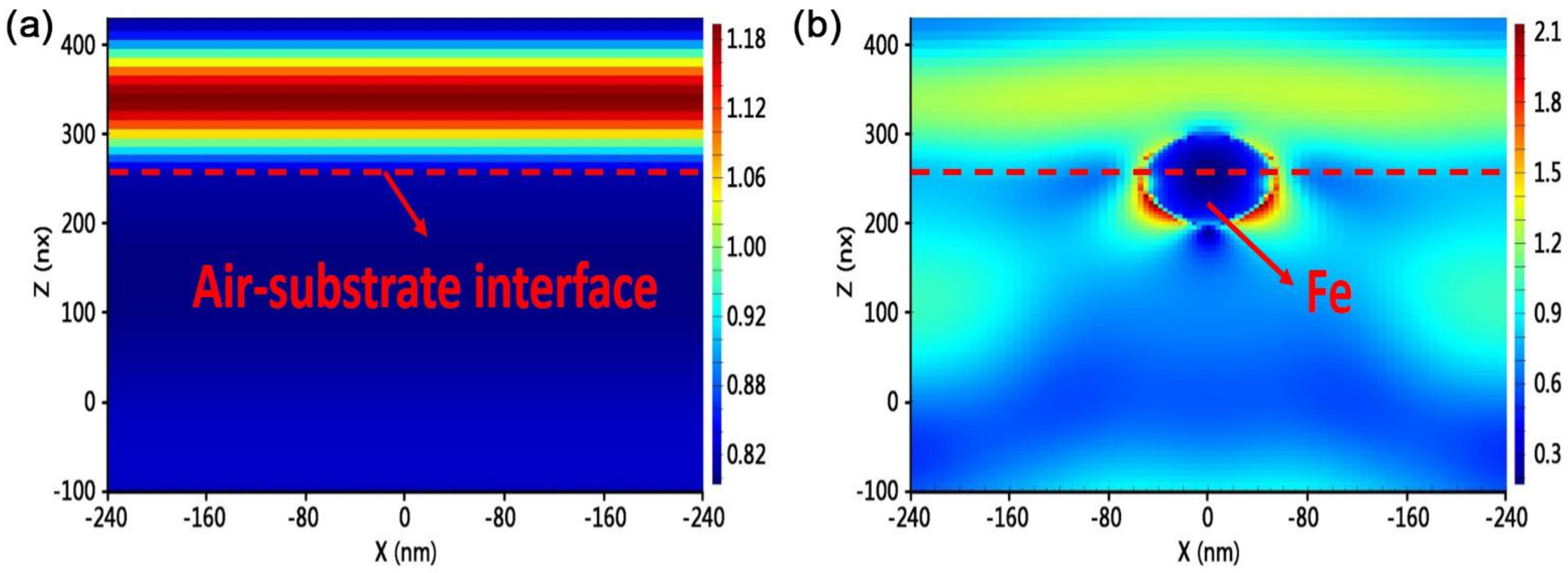




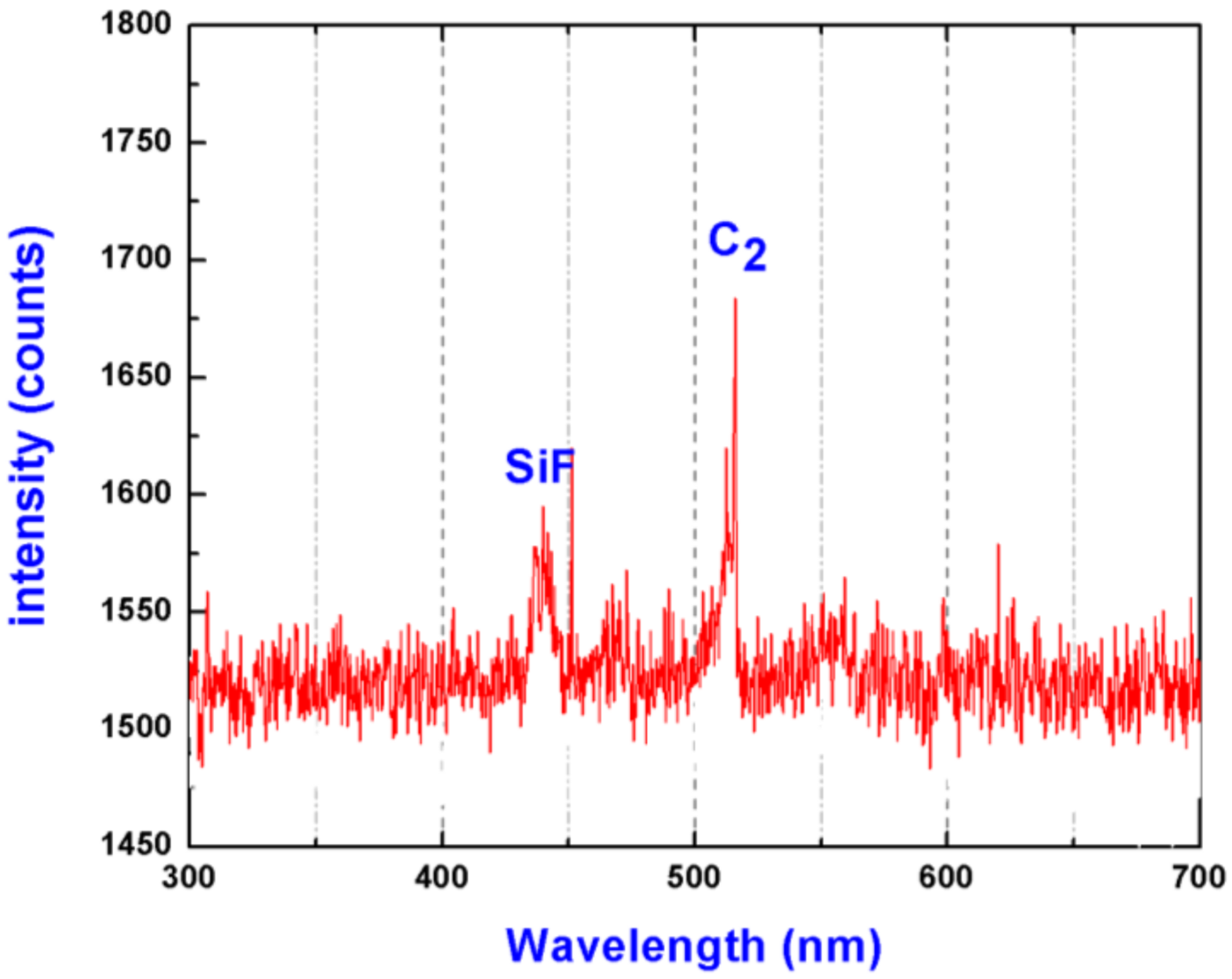

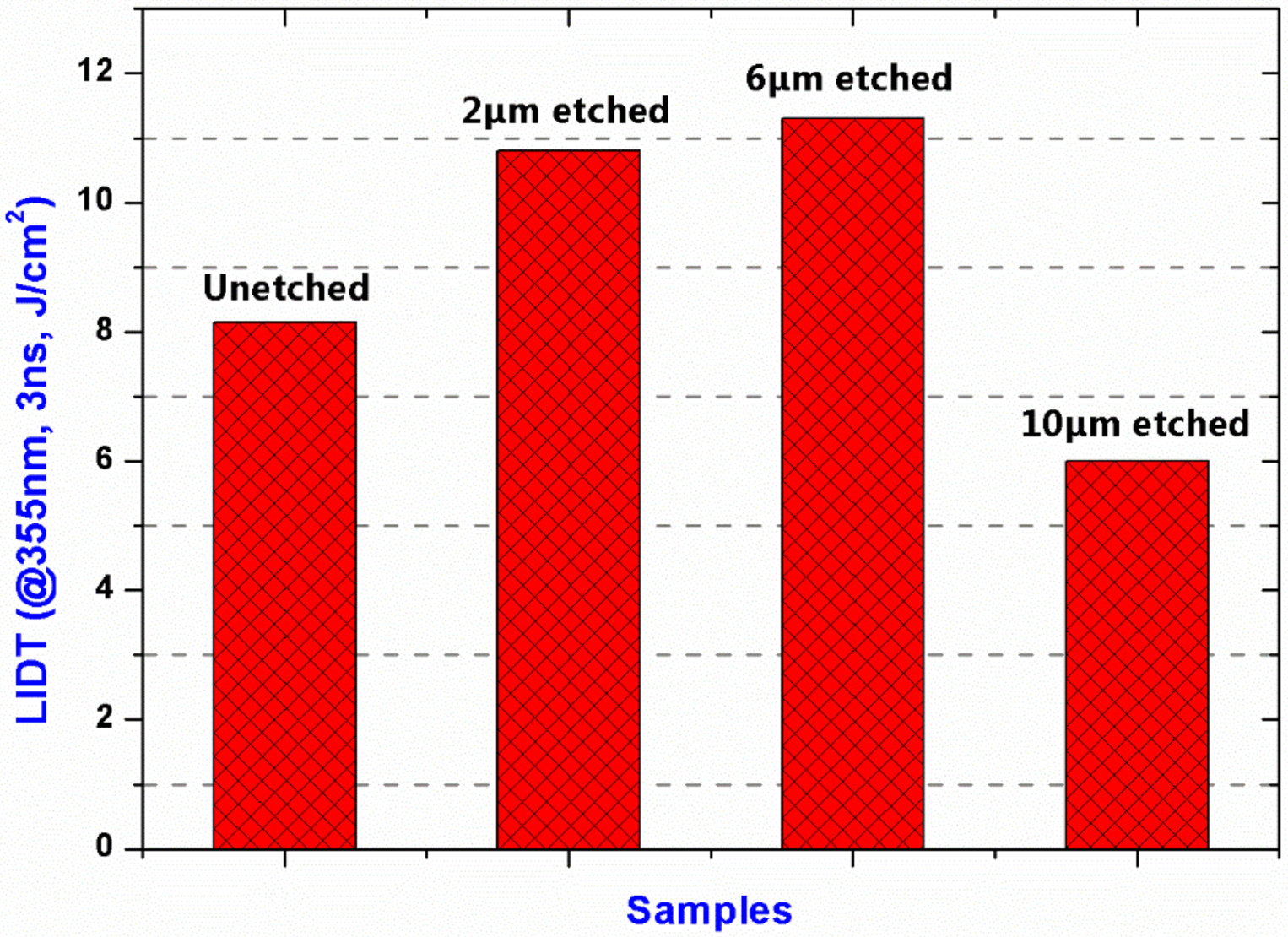


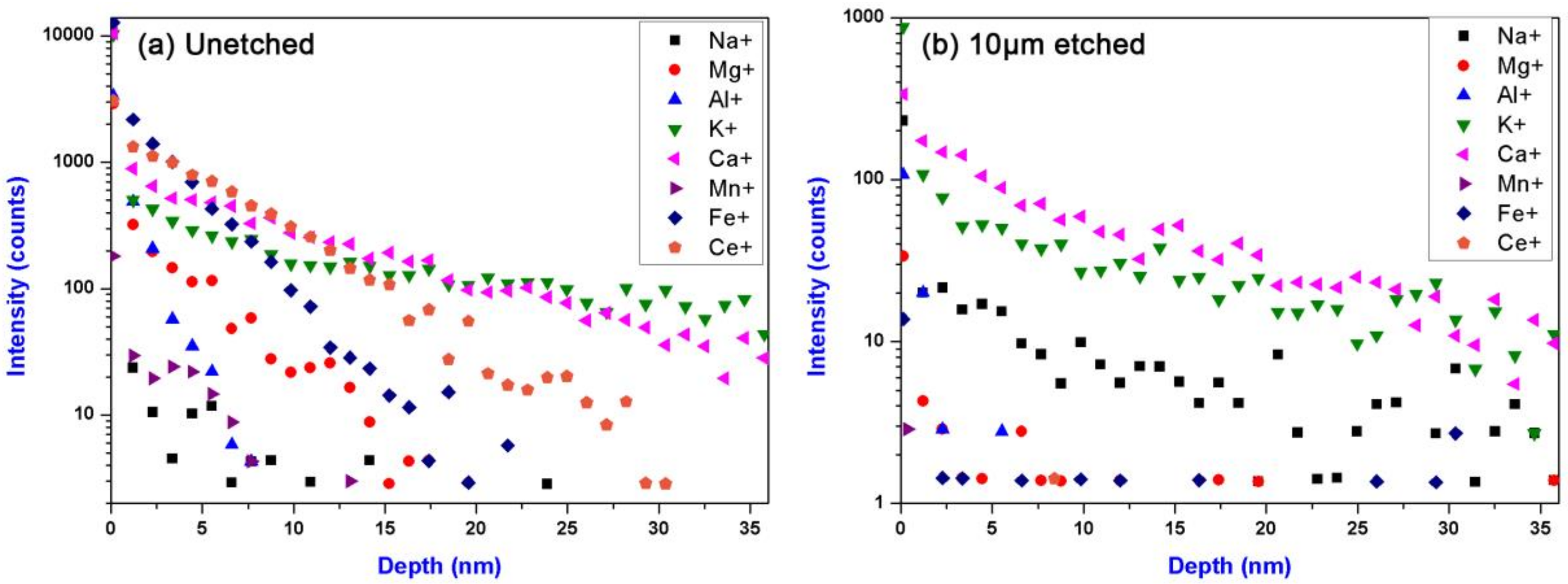
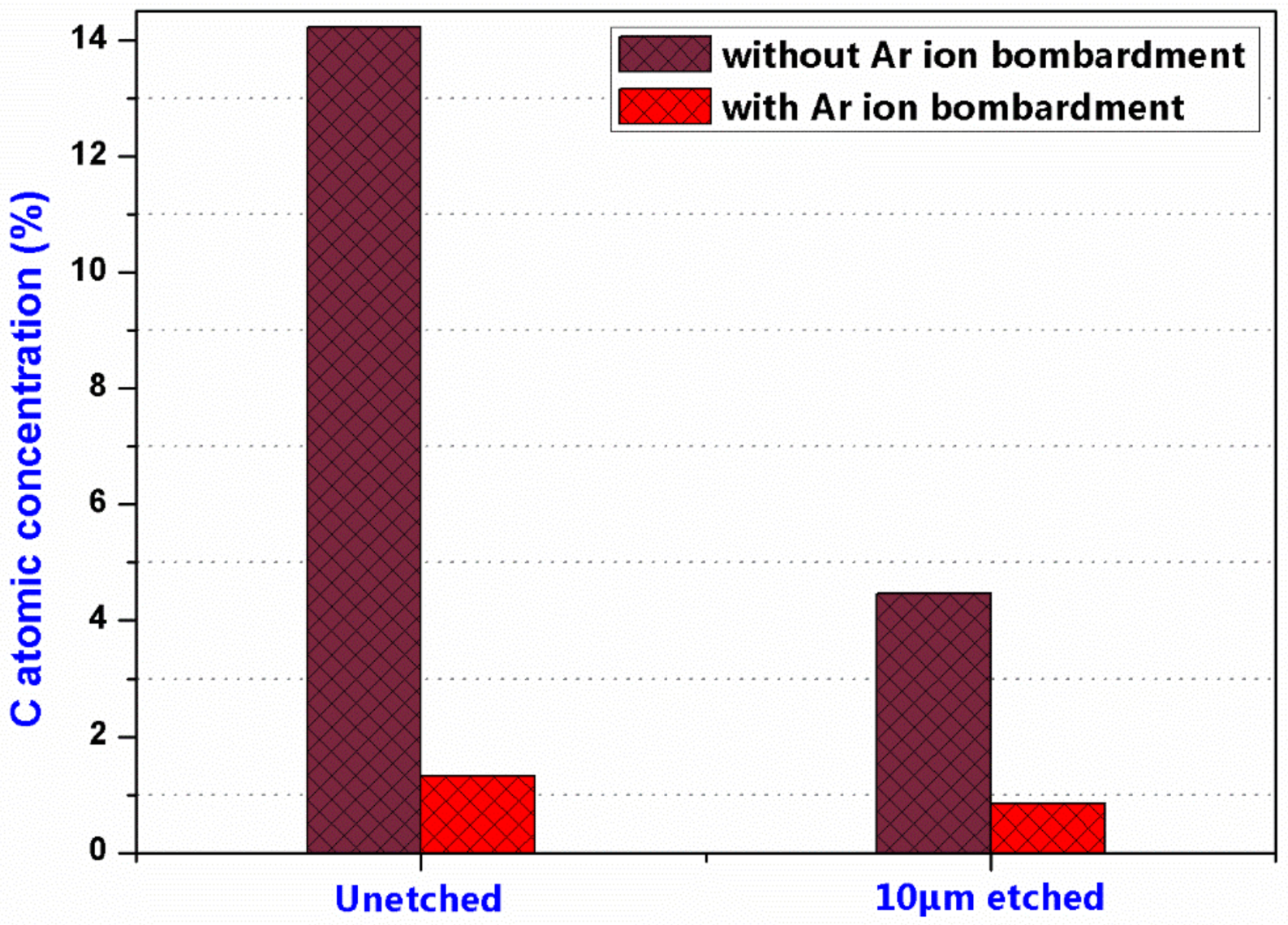
| No | RIE Etching | Etching Depth (μm) |
|---|---|---|
| 1 | No | 0 |
| 2 | Yes | 2 |
| 3 | Yes | 6 |
| 4 | Yes | 10 |
| No. | Etching Depth (μm) | 0% Probability Damage Threshold (J/cm2) | 100% Probability Damage Threshold (J/cm2) | Mean LIDT (J/cm2) |
|---|---|---|---|---|
| 1s | 0 | 5.8 | 9.9 | 8.2 |
| 4s | 10 | 9.0 | 11.9 | 10.9 |
© 2018 by the authors. Licensee MDPI, Basel, Switzerland. This article is an open access article distributed under the terms and conditions of the Creative Commons Attribution (CC BY) license (http://creativecommons.org/licenses/by/4.0/).
Share and Cite
Sun, L.; Shao, T.; Shi, Z.; Huang, J.; Ye, X.; Jiang, X.; Wu, W.; Yang, L.; Zheng, W. Ultraviolet Laser Damage Dependence on Contamination Concentration in Fused Silica Optics during Reactive Ion Etching Process. Materials 2018, 11, 577. https://doi.org/10.3390/ma11040577
Sun L, Shao T, Shi Z, Huang J, Ye X, Jiang X, Wu W, Yang L, Zheng W. Ultraviolet Laser Damage Dependence on Contamination Concentration in Fused Silica Optics during Reactive Ion Etching Process. Materials. 2018; 11(4):577. https://doi.org/10.3390/ma11040577
Chicago/Turabian StyleSun, Laixi, Ting Shao, Zhaohua Shi, Jin Huang, Xin Ye, Xiaodong Jiang, Weidong Wu, Liming Yang, and Wanguo Zheng. 2018. "Ultraviolet Laser Damage Dependence on Contamination Concentration in Fused Silica Optics during Reactive Ion Etching Process" Materials 11, no. 4: 577. https://doi.org/10.3390/ma11040577
APA StyleSun, L., Shao, T., Shi, Z., Huang, J., Ye, X., Jiang, X., Wu, W., Yang, L., & Zheng, W. (2018). Ultraviolet Laser Damage Dependence on Contamination Concentration in Fused Silica Optics during Reactive Ion Etching Process. Materials, 11(4), 577. https://doi.org/10.3390/ma11040577




